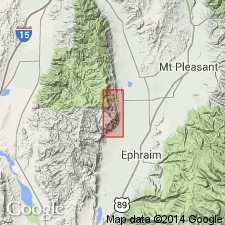
- Usage in publication:
-
- Wales Tongue*
- Modifications:
-
- Named
- Dominant lithology:
-
- Limestone
- Dolomite
- AAPG geologic province:
-
- Wasatch uplift
Summary:
Named as a tongue of Flagstaff Limestone. Overlies and intertongues with unnamed calcareous siltstone unit of North Horn Formation. Is separated from main body of Flagstaff by unnamed upper redbed unit of North Horn. Named for occurrence in Wales Canyon, sec. 27, T 15 S, R 2 E; type locality designated in SW 1/2 sec. 35, T 15 S, R 2 E and N 1/2 sec. 2, T 16 S, R 2 E in Petes Canyon, Sanpete Co. to south where the member is better exposed. Is 390 ft thick at type; thickens north from Wales Canyon where it is 376 ft thick and it merges with Flagstaff Limestone 2.7 mi north of Wales Canyon through disappearance of the intervening upper redbed unit of the North Horn. Rests on Middle Jurassic Twist Gulch Formation at Dry Canyon, sec. 4, T 17 S, R 2 E; is not present south of Dry Canyon; is widely distributed in the southern, central and eastern San Pitch Mountains, Sanpete Co. Lower part 131 ft thick consists of dark gray micrite interbedded with olive gray claystone and a few sandstone beds that are burrowed and contain gastropod fragments. Brick-red claystone with warty sandy micrite nodules occur at top of lower part. Upper part 262 ft thick is a ledge-forming sequence of dolomite, limestone, and subordinate claystone that weathers white to orange. Some sparse gastropods and sparry algal fragments in upper part. Deposited as a shallow-water, open-lacustrine deposit of Paleocene age.
Source: GNU records (USGS DDS-6; Denver GNULEX).
For more information, please contact Nancy Stamm, Geologic Names Committee Secretary.
Asterisk (*) indicates published by U.S. Geological Survey authors.
"No current usage" (†) implies that a name has been abandoned or has fallen into disuse. Former usage and, if known, replacement name given in parentheses ( ).
Slash (/) indicates name conflicts with nomenclatural guidelines (CSN, 1933; ACSN, 1961, 1970; NACSN, 1983, 2005, 2021). May be explained within brackets ([ ]).

